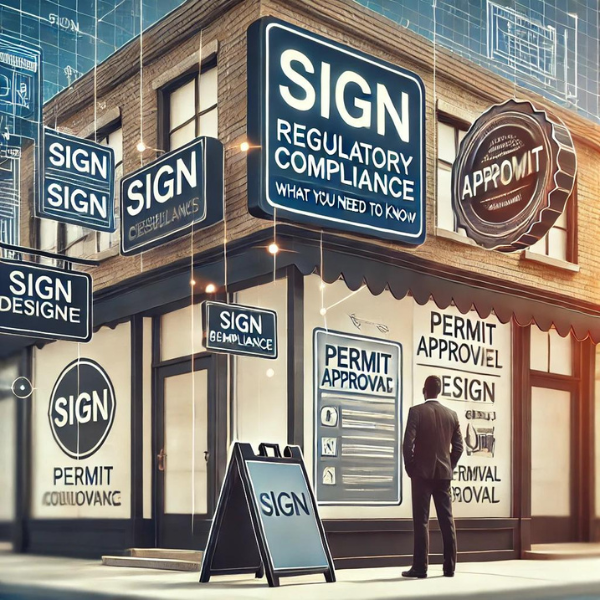Signage plays a critical role in branding, advertising, and guiding customers, but it’s not just about design and placement. To ensure your signs are effective and legally compliant, it’s essential to understand the regulatory landscape surrounding signage. Failing to comply with local, state, or federal regulations can result in fines, required modifications, or even removal of your signage. This article delves into the key aspects of regulatory compliance in signage, helping you navigate the rules and avoid potential pitfalls.
Understanding the Importance of Signage Compliance
Signage regulations are in place to ensure public safety, maintain aesthetic standards, and prevent visual clutter. Compliance is crucial for several reasons:
- Legal Requirements: Regulations govern various aspects of signage, including size, placement, illumination, and content. Ensuring compliance helps avoid legal issues and penalties.
- Public Safety: Regulations often focus on the safety of signs, ensuring they are structurally sound and do not pose hazards to the public.
- Community Standards: Local governments enforce regulations to maintain a certain visual standard within communities, preventing signs from becoming eyesores or causing distractions.
Key Areas of Signage Regulation
To comply with signage regulations, it’s important to understand the key areas typically governed by law:
Zoning Laws:
- Sign Placement: Zoning laws dictate where signs can be placed on a property. These laws vary depending on the type of property (residential, commercial, industrial) and its location (urban, suburban, rural).
- Size and Height: Regulations often set limits on the size and height of signs to prevent them from obstructing views or becoming visually intrusive.
- Setbacks: Setback requirements ensure that signs are placed a certain distance from roads, sidewalks, and property lines, reducing the risk of obstruction or accidents.
Permitting and Approvals:
- Sign Permits: Most jurisdictions require a permit before you can install a new sign. The permitting process typically involves submitting detailed plans, including the sign’s dimensions, materials, and location.
- Review Process: Some areas have a design review process where signs must be approved by a planning board or design committee to ensure they meet community standards.
- Fees and Inspections: Permit fees and inspections are often part of the process. Inspections ensure that the sign is installed correctly and safely.
Content Regulations:
- Message Content: Regulations may govern the content of signs, especially in public or residential areas. For example, certain types of advertising might be restricted, or there may be rules about offensive or misleading content.
- Digital and LED Signs: Digital signage is subject to specific content regulations, such as limits on brightness, animation, and message duration, to avoid distracting drivers and pedestrians.
Illumination and Lighting:
- Brightness Levels: Regulations often dictate the maximum brightness for illuminated signs to prevent glare or light pollution, particularly in residential areas.
- Operating Hours: Some areas have restrictions on when illuminated signs can be lit, typically requiring them to be turned off during late-night hours to minimize disruption.
- Energy Efficiency: Increasingly, there are regulations promoting the use of energy-efficient lighting, such as LED lights, to reduce environmental impact.
Accessibility and Safety Standards:
- ADA Compliance: Signs in public spaces must comply with the Americans with Disabilities Act (ADA), ensuring they are accessible to people with disabilities. This includes considerations for font size, braille, and contrast.
- Structural Integrity: Regulations require signs to be structurally sound, capable of withstanding wind, weather, and other environmental factors. Regular inspections may be mandated to ensure ongoing safety.
Navigating Local and State Regulations
Signage regulations can vary significantly between different states, counties, and cities. It’s important to research and understand the specific regulations in your area:
- Local Ordinances: Start by checking your local city or county’s website for information on signage regulations. This will include zoning laws, permitting requirements, and any design standards specific to your area.
- State Laws: Some states have overarching signage laws that apply in addition to local regulations. These might cover issues like highway signage, billboard restrictions, or environmental impact assessments.
- Professional Guidance: If you’re unsure about the regulations or face a complex approval process, consider consulting with a signage professional or legal expert who specializes in zoning and permitting.
Common Compliance Challenges and How to Overcome Them
Compliance with signage regulations can be challenging, especially for businesses unfamiliar with the process. Here are some common challenges and tips for overcoming them:
- Complex Permitting Processes: Navigating the permitting process can be time-consuming and complicated. To streamline this, gather all necessary documentation, work with a professional sign installer familiar with local regulations, and allow extra time for approvals.
- Changing Regulations: Signage laws can change, and keeping up with these changes is essential. Stay informed by subscribing to updates from your local government or working with a signage expert who tracks regulatory changes.
- Balancing Creativity with Compliance: Creative sign designs sometimes clash with regulatory requirements. Work closely with designers and regulatory officials to find solutions that meet both aesthetic goals and compliance standards.
Best Practices for Ensuring Signage Compliance
To ensure your signage remains compliant, follow these best practices:
- Research and Plan Early: Start researching regulations and planning your signage project early in the design process to avoid delays and last-minute changes.
- Engage with Authorities: Communicate with local zoning and permitting authorities early and often. They can provide guidance and help you avoid costly mistakes.
- Document Everything: Keep detailed records of permits, approvals, inspections, and any communication with regulatory bodies. This documentation can be invaluable if any compliance issues arise later.
- Regular Inspections and Maintenance: Ensure that your signs are regularly inspected and maintained to comply with safety standards and local regulations. This includes checking for structural integrity, illumination levels, and overall condition.
Consequences of Non-Compliance
Non-compliance with signage regulations can have serious consequences for your business:
- Fines and Penalties: Businesses found in violation of signage regulations can face hefty fines, which can quickly add up if the issue isn’t resolved promptly.
- Forced Removal or Modification: Non-compliant signs may need to be removed or modified to meet regulations, leading to additional costs and potential disruptions to your business.
- Legal Action: In some cases, continued non-compliance can result in legal action, further increasing costs and damaging your business’s reputation.
Conclusion: Staying Compliant in a Complex Regulatory Environment
Signage is a critical component of your business’s marketing and branding strategy, but it’s essential to ensure that your signs comply with all relevant regulations. By understanding the key areas of signage regulation, navigating the local and state requirements, and following best practices, you can avoid the pitfalls of non-compliance and create effective, legally sound signage that enhances your business.

SignDelivery Inc. & VanWraps.com
- Custom Vehicle Wraps: Transform your vehicle into a powerful marketing tool with our custom-designed, high-quality wraps.
- Comprehensive Signage Solutions: From durable metal signs to eye-catching digital prints, we cater to all your signage needs with precision and creativity.
- Expert Design Services: Our experienced team delivers custom graphic designs and logos that elevate your brand and resonate with your audience.
- Experience & Quality: With two decades of experience, we guarantee top-tier quality and customer satisfaction.
- Full-Service Approach: We handle everything from design to installation, providing a seamless experience.
- Sustainable Solutions: Our vinyl wraps are not only visually appealing but also eco-friendly, helping you refresh old signs without waste.
- Phone: 901-521-SIGN
- Explore more at SignDelivery.com and VanWraps.com
Featured Articles

Trends in Signage: What’s New in 2024
Stay ahead in 2024 with the latest signage trends, from AI-driven digital displays to eco-friendly materials and minimalist designs. Discover how these innovations are transforming the signage industry, enhancing brand visibility, and meeting modern consumer expectations.

Regulatory Compliance in Signage: What You Need to Know
Navigating the world of signage regulations is essential for any business. This guide covers the key aspects of regulatory compliance, helping you ensure your signs meet all legal requirements, from size and placement to content and illumination. Avoid fines and legal issues by understanding and adhering to signage regulations.

The Role of Signs in Retail: Driving Foot Traffic and Sales
Effective signage is a powerful tool in retail, capturing attention, guiding customers, and driving sales. Discover how well-designed and strategically placed signs can transform foot traffic into loyal customers and boost your bottom line. Explore the types of retail signs, best practices, and real-world examples of signage success in this comprehensive guide.

Sign Maintenance: How to Keep Your Signs Looking New
Maintaining your signage is crucial for preserving its impact and longevity. Discover best practices for keeping your signs looking new, including innovative solutions like vinyl wraps from SignDelivery.com. Learn how to extend the life of your signage, save costs, and contribute to environmental sustainability by refreshing old signs instead of replacing them.
Featured Products
A2 Hosting WordPress Plugin
Wordpress Plugins$12.99Original price was: $12.99.$1.95Current price is: $1.95.Rated 5.00 out of 5AAWP Amazon Affiliate WordPress Plugin
Wordpress Plugins$49.00Original price was: $49.00.$24.50Current price is: $24.50.Rated 5.00 out of 5Adobe Creative Cloud | Entire Collection of Adobe Creative Tools Plus 100GB Storage | 1-Month Subscription with Auto Renewal, PC/Mac
Adobe $659.88Rated 4.00 out of 5H-E “High- End” AC220V 51″ x 98″1325 Ad and Woodworking CNC Router Machine, with 3KW Spindle – US Stock
CNC $12,323.00Rated 5.00 out of 5
Special Offer
Get a Free Custom Lighter Wrap!
Signbot.io is excited to offer you a completely free, no-strings-attached custom lighter wrap! Simply design your own unique lighter wrap using our intuitive design tool, place your order, and we'll ship it to you at no cost. It's our way of saying thank you for exploring the world of custom wraps with Signbot.io. Start designing now and light up your style with Signbot.io
Design and Order Yours Now!
Understanding The Art of Signage
A comprehensive series exploring all aspects of signage, from historical evolution and design principles to modern materials, installation techniques, and emerging trends. This category provides valuable insights for anyone looking to understand and master the art of signage in today’s dynamic industry.










